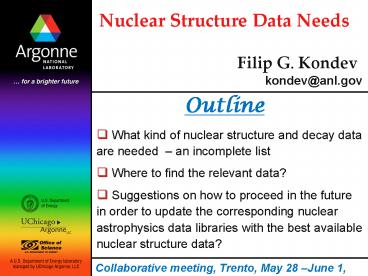Nuclear Structure Data Needs - PowerPoint PPT Presentation
1 / 11
Title:
Nuclear Structure Data Needs
Description:
Where to find the relevant data? Suggestions on how to proceed in the future in ... ANL in collaboration with JINA and other interested groups can provide the ... – PowerPoint PPT presentation
Number of Views:27
Avg rating:3.0/5.0
Title: Nuclear Structure Data Needs
1
Nuclear Structure Data Needs
- Filip G. Kondev
kondev_at_anl.gov
Outline
- What kind of nuclear structure and decay data
are needed an incomplete list - Where to find the relevant data?
- Suggestions on how to proceed in the future in
order to update the corresponding nuclear
astrophysics data libraries with the best
available nuclear structure data?
Collaborative meeting, Trento, May 28 June 1,
2007
2
What NS data are needed?
- Priority 1 masses decay data
- masses, T1/2, decay modes BR and
delayed-particle emission probabilities - Priority 2 level energies, quantum numbers,
T1/2 of excited states, etc. - depends on the site of nucleosynthesis
- s- and p-processes near the valley of
stability a lot of data - rp-process at the proton-rich side
- r-process - at the neutron-rich side much
more data is expected in the future with the RIB
facilities - important for model (cross-section) calculations
level densities, partition functions, etc. - important when we are dealing with isomers
cosmo-chronometers at the s-process path, but
also many at the n-rich side - including the atomic (electron) environment?
3
Where to find the data ENSDF?
Effort within NSDD network, under auspices of
IAEA. Database is managed by NNDC (BNL)
Contents Evaluated nuclear structure and decay
data for all known nuclei, organized in over 260
mass chains
ENSDF
Reactions (HI,xn?) (p,p) (n, ?), (n,xng) Coul.
Exc. (?,?), (a,xng) (d,p), etc.
Adopted (best values) Levels (E, J?, T1/2, ?, Q,
configurations) Gammas (Eg, BR, M,?, ICC)
Decays ?- ?? ? ?-n etc.
www.nndc.bnl.gov/ensdf
4
Where to find the data - cont?
Atomic Masses (Audi, Wapstra)
Nuclear Science References (NSR)
www.nndc.bnl.gov/ensdf
- Pros
- effort that already exists - updated on regular
basis - (NSDD Network under the auspices of IAEA)
- ALL experimental NS data for ALL nuclei
ENSDF
RIPL
ENDF/JENDL/JEFF
NuBase
- Cons
- updating time vary between 6 to 10 years in
some cases - not all data are relevant to the needs of the
astrophysics community - strange format
5
Where to find the data - cont?
http//www.nucleide.org/DDEP_WG/DDEPdata.htm
- Pros
- include comprehensive X-ray data
- updated on regular basis
- Cons
- decay data only
- mostly for NE metrology applications
- relevant to a handful of s-(p-) process nuclei
6
Where to find the data - cont?
http//amdc.in2p3.fr/web/nubase_en.html
- Pros
- based on ENSDF, but updated for recent data
- Cons
- updating time 5-8 years
- no spectral information
- continuity
Atomic Masses Evaluations?
7
What would be useful to have?
- although ENSDF is the best source for a variety
of experimental NS and decay data, effort is
needed to (i) extract the needed data for
astrophysics applications in user defined formats
(ii) to update for recent discoveries (30 new
isotopes/yr) - results from model calculations should be also
included for many nuclei, especially on the
neutron-rich side, experimental data do not exist - in an ideal case scenario - a merge between
experimental theoretical data is needed
development of a dedicated Astrophysics Nuclear
Structure Data (ANSD) module easily included
into Reaclib (or any other library)
8
A N Z E E/T T1/2 E/T
Decay Mode E/T Delayed Particle Emission
E/T 0/1 0/1 b-
eb a 0/1 n p a
0/1 77 38 39 0.0 0 63 MS 12
0 0 100 0 0
0 10 1 2.2 0.5 0
9
What Id like to propose?
- ANL in collaboration with JINA and other
interested groups can provide the Astrophysics
Nuclear Structure Data (ANSD) module - updates will be provided regularly once a year
- data will be peer-reviewed by expert(s) in the
field - the ANSD module will be a merge between
experiment theory - it will include available
experimental data for all known nuclei, together
with predictions for those not yet known - the corresponding codes used to merge
(manipulate) the experimental theoretical data
sets will be provided, together with subroutines
that can read the corresponding data files
10
What would be the benefits?
- Comprehensive Complete
- All related quantities will be provided,
together with estimates of their uncertainties - Reliable
- Data will be correctly represented
- Up-to-Date
- Consequences of new measurements will appear
promptly regular updates will be provided - Accessible
- Data will be available in an user-defined format
- You will have all that for FREE sorry no
charges
11
What about other data?
Priority 2 level energies, quantum numbers, T1/2
of excited states, etc. the needs for dedicated
effort should be driven by the users and modelers
many of those can be find in ENSDF if there
is a need we can provide it
Priority 1 usually a comparison between
experimental and theoretical T1/2 is used to test
the reliability of a particular model - what
about the b-decay strength distributions from
decay schemes TAGS?































